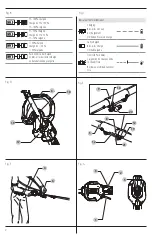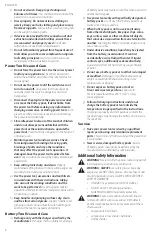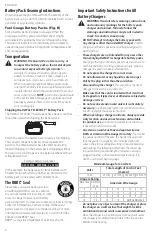
5
English
•
Do not charge or use the battery pack in explosive
atmospheres, such as in the presence of flammable
liquids, gases or dust.
Inserting or removing the battery
pack from the charger may ignite the dust or fumes.
•
NEVER force the battery pack into the charger. DO
NOT modify the battery pack in any way to fit into a
non‑compatible charger as battery pack may rupture
causing serious personal injury.
Consult the chart
at the end of this manual for compatibility of batteries
and chargers.
•
Charge the battery packs only in
D
e
WALT
chargers.
•
DO NOT
splash or immerse in water or other liquids.
•
DO NOT
allow water or any liquid to enter battery pack.
•
Do not store or use the tool and battery pack in
locations where the temperature may reach or
exceed 104 °F (40 °C) (such as outside sheds or metal
buildings in summer).
For best life store battery packs in
a cool, dry location.
NOTE: Do not store the battery packs in a tool with
the trigger switch locked on. Never tape the trigger
switch in the ON position.
•
Do not incinerate the battery pack even if it is severely
damaged or is completely worn out.
The battery pack
can explode in a fire. Toxic fumes and materials are created
when lithium‑ion battery packs are burned.
•
Do not expose a battery pack or appliance to fire or
excessive temperature.
Exposure to fire or temperature
above 265 °F (130 °C) may cause explosion.
•
Follow all charging instructions and do not charge the
battery pack or appliance outside of the temperature
range specified in the instructions.
Charging improperly
or at temperatures outside of the specified range may
damage the battery and increase the risk of fire.
•
If battery contents come into contact with the skin,
immediately wash area with mild soap and water.
If
battery liquid gets into the eye, rinse water over the open
eye for 15 minutes or until irritation ceases. If medical
attention is needed, the battery electrolyte is composed of a
mixture of liquid organic carbonates and lithium salts.
•
Contents of opened battery cells may cause
respiratory irritation.
Provide fresh air. If symptoms
persist, seek medical attention.
•
Battery liquid may be flammable if exposed to spark
or flame.
•
Never attempt to open the battery pack for any
reason. If the battery pack case is cracked or
damaged, do not insert into the charger.
Do not crush,
drop or damage the battery pack. Do not use a battery pack
or charger that has received a sharp blow, been dropped,
run over or damaged in any way (e.g., pierced with a nail,
hit with a hammer, stepped on). Damaged battery packs
should be returned to the service center for recycling.
Storage Recommendations
The best storage place is one that is cool and dry, away
from direct sunlight and excess heat or cold. Store the fully
charged battery pack out of the charger.
READ ALL INSTRUCTIONS
Important Safety Instructions for All
Battery Packs
WARNING:
Read all safety warnings, instructions,
and cautionary markings for the battery pack,
charger and product. Failure to follow the
warnings and instructions may result in electric
shock, fire and/or serious injury.
BATTERIES AND CHARGERS
The battery pack is not fully charged out of the carton.
Before using the battery pack and charger, read the
safety instructions below and then follow charging
procedures outlined. When ordering replacement battery
packs, be sure to include the catalog number and voltage.
The label on your tool may include the following symbols. The
symbols and their definitions are as follows:
BPM ....................beats per minute
V ......................... volts
min .....................minutes
j
or DC ............direct current
…/min ..............per minute
RPM .................... revolutions per
minute
A .........................amperes
Hz .......................hertz
W ........................watts
Wh ......................watt hours
no .......................no load speed
n .........................rated speed
c
.....................safety alert symbol
h
..................... wear respiratory
protection
f
..................... wear eye protection
i
..................... Class II Construction
(double insulated)
g
..................... wear hearing
protection
a
..................... read all
documentation
n
..................... avoid staring at
light
l
or AC............alternating current
Ah ....................... amp hours
• arsenic and chromium from chemically
treated lumber.
To reduce your exposure to these chemicals, wear
approved safety equipment such as dust masks that
are specially designed to filter out microscopic particles.
WARNING:
Use of this tool can generate and/or
disperse dust, which may cause serious and permanent
respiratory or other injury. Always use NIOSH/OSHA
approved respiratory protection appropriate for
the dust exposure. Direct particles away from face
and body.
WARNING:
Always wear proper personal hearing
protection that conforms to ANSI S12.6 (S3.19)
during use.
Under some conditions and duration
of use, noise from this product may contribute to
hearing loss.
CAUTION:
When not in use, place tool on its
side on a stable surface where it will not cause a
tripping or falling hazard.
Some tools with a large
battery pack will stand upright but may be easily
knocked over.
•
Air vents often cover moving parts and should be
avoided.
Loose clothes, jewelry or long hair can be caught
in moving parts.








































